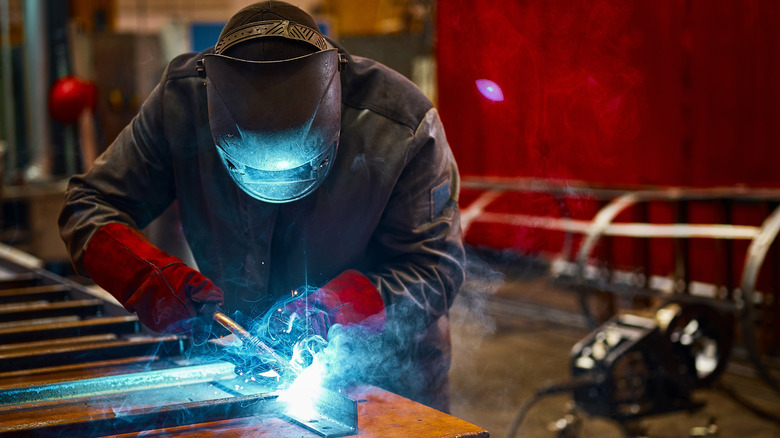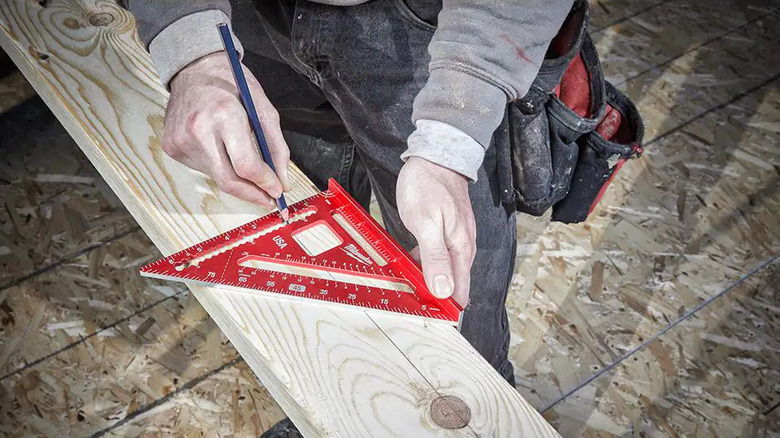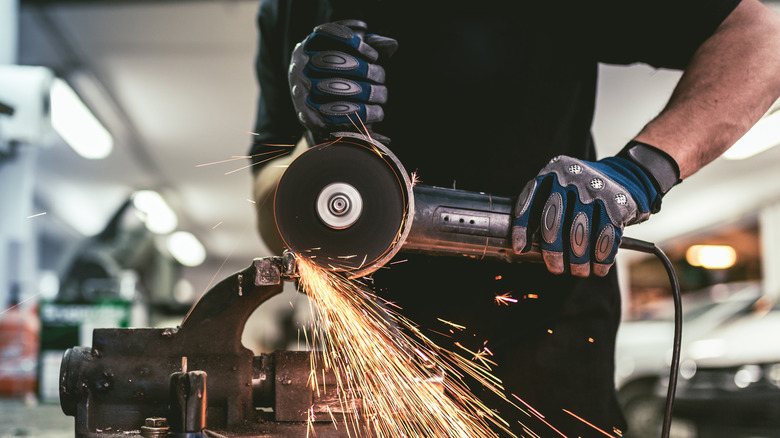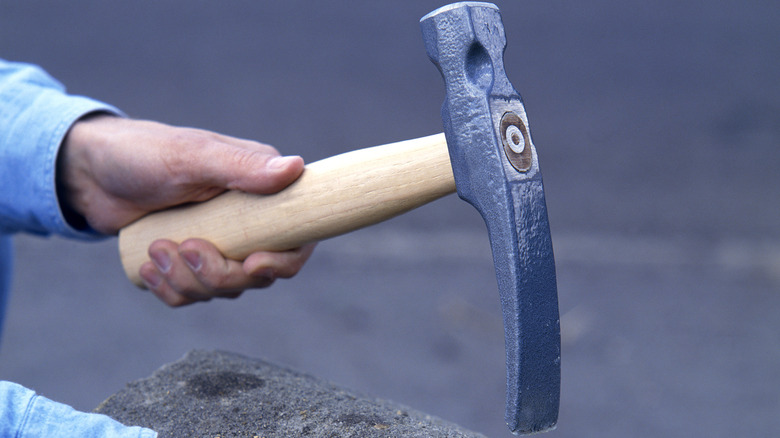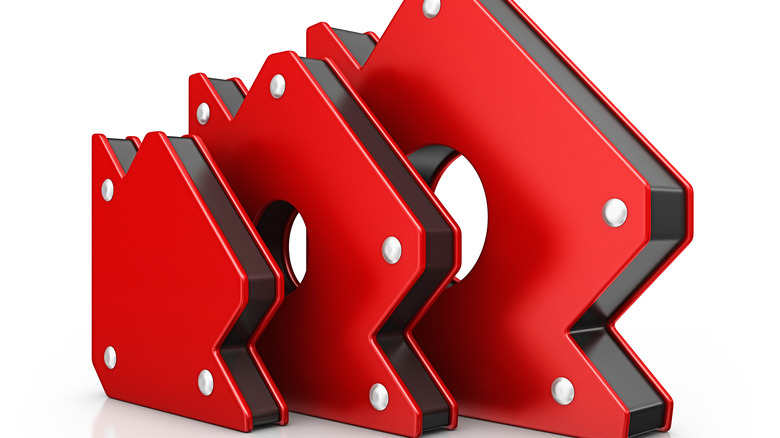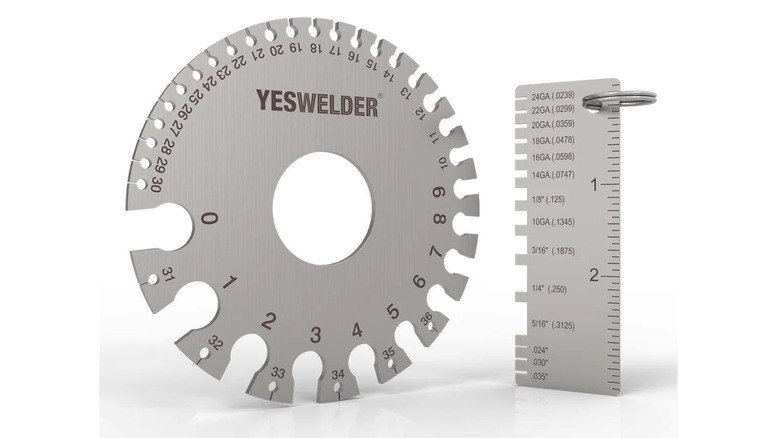5 Essential Tools To Kickstart Your Welding Career
There are several ways to join two pieces of metal — whether it's for construction, artwork, or any number of other applications — but welding is a common way to do it. Welding can create a stronger bond between two materials with a flawless seam and can be more efficient and versatile than other methods like soldering and riveting. That's exactly why welding is a popular choice as a profession — there's always work to be done. If you're just starting a career in welding or are looking to get into it as a hobby, you're going to need some basic equipment.
There are three main types of welding: gas welding, arc welding, and the most recently developed form, laser welding. Depending on what type you're getting started with, you'll need different kinds of equipment to conduct the actual welding. You may choose to do more than one of these, as the principles of how all three work are relatively similar. However, there's still a lot of equipment and tools that are universal among these welding types, so even if you haven't decided what to focus on yet, you can start building your kit.
You'll certainly need safety equipment and gear like welding gloves and a helmet to protect your face and eyes. But you'll also need specific tools that every welder requires to do their work. Here are five of the most essential tools you'll need to kick-start your welding career.
Speed Square
Of all the tools you'll need while welding, a speed square might be the one you end up using the most — over and over throughout every project. That's why you'll want to make sure that you not only have a speed square on you at all times but also that it's durable and lightweight so that you can easily have it on hand all the time. Speed squares, also known as rafter squares, are easy to spot in a hardware store because of their triangle shape. They're used to measure two pieces together at various angles you'll need to make a cut.
You can find plenty of options for speed squares from various retailers. Popular tool manufacturer Milwaukee makes a seven-inch rafter square that's available on Amazon for $18.97. It's built from durable aluminum and has Milwaukee's signature red color, so it stands out and will be easy to spot in your workspace when you need to reach for it. It also has laser-etched markings that are easy to read and a one-inch cutout props pipe. It's a little pricier than other options on Amazon, however. Also, while a seven-inch speed square can fit better in your pocket, some welders prefer a 12-inch tool. So you may end up deciding to go with another speed square if you want something bigger or slightly cheaper.
Angle Grinder
One tool you'll want to always have on hand when welding is an angle grinder. While the whole point of welding is to join two materials — like metal — together, sometimes you'll also need to cut metal, like when slicing off a piece of some stock. Angle grinders are great for this purpose but can also be used to clean base metal before welding. That can be done with a wire brush or other ways, but a powered angle grinder can get the job done quickly. Similarly, angle grinders are also good at polishing up the metal you're working on and grinding down any leftover slag.
An angle grinder is a common handheld power tool used in many professions, which makes it easier to come by in most hardware stores and other retailers than more specialized welding equipment. You'll want to make sure you get a good quality grinder, and several tool manufacturers make ones you can rely on, like Hitachi, Black+Decker, and Milwaukee.
One good option is the angle grinder made by DeWalt, which has an 11-amp motor that can generate 11,000 rpm for speedy material removal. It also has a dust ejection system that keeps debris out of the tool. However, it's not cordless, which makes it less convenient than some other angle grinders, so you may factor that into which product you ultimately purchase. The DeWalt 4.5-inch Angle Grinder can be found on Amazon with a list price of $109.
Chipping Hammer
As you begin welding, you'll quickly notice that slag will condense on the pieces you're working on. You'll likely need to chip away at this slag before you're done to ensure a smooth and polished finish. This is why you'll want to include a chipping hammer in your tool kit when you embark on your welding career. Chipping hammers are exactly what they sound like, but unlike more commonly recognized claw hammers or tack hammers, chipping hammers have a flat side and a pointed side that are optimized for different types of slag. Even if you're not using a chipping hammer on every weld, you'll be glad you have one on hand when the time comes to get rid of some unwanted slag.
The Estwing Big Blue is a popular premium chipping hammer among welders due to its high-quality build and comfortable grip. It's an 11-inch hammer that weighs less than 14 ounces and would be a great addition to your welding tool kit. However, it's a lot pricier than other options available, some of which will also come with wire brushes and other useful accessories when dealing with slag. Other chipping hammers are also lighter and/or come with spring handles, which you may personally prefer. But the Estwing Big Blue, which costs $34.57 on Amazon, is a solid choice if none of that matters to you.
Welding Magnets
You may end up including clamps in your welding tool kit since you'll need something to hold the metal in place while you work on it. However, another option is to use magnets instead. They can be more versatile than clamps, able to hold metal at angles clamps may not be able to achieve. Plus, they're typically easier to move and manipulate than clamps. Keeping metal firmly in place while welding is incredibly important, so if you have a set of welding magnets, you'll be using them constantly.
Welding magnets are relatively cheap and easy to find. Amazon has a wide variety of options to choose from. Spurtar sells a set of four welding magnets on Amazon for $17.99 that can support any ferrous metal up to 50 pounds at 45-, 90-, and 135-degree angles. The magnets are durable and long-lasting, made from stainless steel and coated in a nice-looking red finish — so you won't have to worry about rust.
While they're a good choice, there are plenty of other welding magnets you can find online or in hardware stores, and you may go with a different-sized set or magnets capable of holding more than 50 pounds. Whichever ones you go with, you'll be glad you have welding magnets in your tool kit.
Sheet Metal Gauge
A sheet metal gauge is a simple — yet essential — piece of equipment that will quickly tell you how thick the metal you're working with is, which is vital information you'll need before you begin welding. Even professional welders who've been working for years know better than to trust their eyeballs when figuring out the width of a piece of metal because even being slightly off could prove disastrous for the job.
A sheet metal gauge is typically round or shaped like a straight ruler, with multiple teeth spaced apart that are different widths corresponding to the standard gauges sheet metal is often found in. With the tool, you can quickly ascertain the width of the metal you're welding. Sheet metal gauges are cheap and easy to find, and you should pick one up before beginning any welding.
One example is Yeswelder's set of two gauges — one round and one straight. They're dual-sided, lightweight, and made of durable stainless steel. Plus, they come with a leather carrying case. You can find the Yeswelder sheet metal gauge two-pack for $13.66 on Amazon, which sells many other sheet metal gauge options from other brands as well.
